Serviços Personalizados
Artigo
Indicadores
Links relacionados
-
 Citado por Google
Citado por Google -
 Similares em Google
Similares em Google
Compartilhar
Water SA
versão On-line ISSN 1816-7950
versão impressa ISSN 0378-4738
Water SA vol.35 no.4 Pretoria Jul. 2009
Survey of disinfection efficiency of small drinking water treatment plants: Challenges facing small water treatment plants in South Africa
MNB MombaI, *; CL ObiII; P ThompsonIII
ITshwane University of Technology, Department of Environmental, Water and Earth Sciences, Arcadia Campus, P/B X 680, Pretoria 0001, South Africa
IIAcademic and Research Directorate, Walter Sisulu University, Mthatha, South Africa
IIIUmgeni Water PO Box 9, Pietermaritzburg 3200, South Africa
ABSTRACT
A survey involving 181 water treatment plants across 7 provinces of South Africa: Mpumalanga, Limpopo, North West, Free State, KwaZulu-Natal, Eastern Cape and Western Cape was undertaken to identify the challenges facing small water treatment plants (SWTPs) in South Africa . Information gathered included ownership and design capacity of the plants, water sources, and various methods of disinfection, equipment currently employed and performance of the treatment plants. In general, the majority (over 80%) of the SWTPs surveyed in the designated provinces were owned by the district municipalities. The designed capacities of these plants varied between 1 and 60 Mℓ/d; the smallest capacity was 100 m3/d and the largest 120 Mℓ/d. The small water treatment plants abstracted their raw water from either surface or groundwater or a combination of both water sources with greater preponderance for surface water sources (over 86%). Water treatment practices were noted to be the conventional types mainly coagulation, flocculation, sedimentation, filtration and disinfection. Two types of coagulants namely polyelectrolyte (66%) and alum (18%) were commonly used by the water treatment plants across the provinces studied. Rapid gravity filtration, pressure filter and slow sand filtration systems accounted for 60%, 23% and 9% of the filtration systems across the provinces, respectively. The predominant types of disinfectants employed were chlorine gas (69%) followed by sodium (15%) and calcium (14%) hypochlorite. Over 50% of the various SWTPs did not comply with the SANS 241 Class I (< 1 NTU) and Class II (1 to 5 NTU) recommended turbidity values. The recommended target range of 0.3 to 0.6 mg/ℓ free chlorine residual concentrations at the point of use was not always met by 40% of the plants. Seventy percent of the SWTPs complied with the SANS 241 criteria of microbiological safety of drinking water vis-à-vis total and faecal coliforms. Operational problems affecting the efficiency of small water treatment plants included: inability to appropriately determine the flow rate, chemical dosage and turbidity, lack of chlorine residual at the point of use and lack of water quality monitoring. To produce safe drinking water, appropriate operational practices must be implemented in all small water treatment plants.
Keywords: disinfection, efficiency, drinking water, small water treatment plants, challenges
Introduction
The primary purpose of water treatment is to render the water fit for human consumption. This requires the improvement of microbiological quality and the control of dangerous chemical substances and metals. Secondary purposes include maintenance and protection of distribution and plumbing systems and the management and control of aesthetic quality such as taste, odour, colour and hardness (WHO, 1982).
In South Africa, water infrastructure is well developed in urban areas as opposed to rural areas where the infrastructure is either poorly developed or non-existent. The supply of water to rural communities is usually undertaken through small water treatment plants, defined as water treatment systems that are installed in areas which are not well serviced and which do not normally fall within the boundaries of urban areas. They include water supplies from boreholes and springs which are then chlorinated, treatment plants of small municipalities and establishments such as rural hospitals, schools, clinics and forestry stations. However, the efficacy of small water treatment plants is plagued by several technical and management problems, which include: the inability of plant operators to calculate chlorine dosages, determine flow rate, and estimate free chlorine residual concentrations, undertake readings of turbidity and pH values, or effect repairs of basic equipment. In addition, there appears to be lack of understanding of process selection, design, chlorination techniques, process quality monitoring and evaluation. Others include poor working conditions, the frequent depletion of chemical stock, lack of a maintenance culture, lack of emergency preparedness and poor communication (Swartz, 2000; Mackintosh and Colvin, 2003; Momba et al., 2004ab; 2006; Momba and Brouckaert, 2005; Obi et al., 2007). In addition, many of the SWTP sites are remote and secluded – this may result in limited technical support which often leads to dysfunctional disinfection systems. This is corroborated by the extensive documentation on the supply of water of poor microbiological quality, which is unsafe for human consumption, in different provinces of South Africa.
Contaminated water is a vehicle for several waterborne diseases such as cholera, typhoid fever, shigellosis, salmonellosis, campylobacteriosis, giardiasis, cryptosporidiosis and Hepatitis A viral infections. Such infections cause great debilitation including a substantial degree of morbidity and mortality in different age groups in both males and females, with ripple effects on socio-economic and health care systems.
Although the primary reasons for disinfection problems experienced at small water systems have been previously documented, efforts to address these problems have been fragmented or conducted in a piecemeal manner. There was therefore a need to conduct a survey of disinfection efficiency of these water systems nationwide in order to determine the nature and full extend of the challenges facing the small water treatment plants. This study documents the physicochemical, microbiological, technical and administrative parameters affecting the efficiency of disinfection of SWTPs across provinces in South Africa.
Survey area
To ensure a comprehensive coverage of the country, a survey of 181 small water treatment plants was conducted. These were mainly located in rural communities of the following provinces: Limpopo, Mpumalanga, North West, Free State, KwaZulu-Natal, Eastern Cape and Western Cape. The 7 provinces were selected on the basis of familiarity with the areas, economic status, and rural areas experiencing technical and management problems.
Survey methodology
A questionnaire was designed to obtain the required information such as: the ownership and design capacity of each water treatment plant, the type of raw water sources, the pre-disinfection and disinfection processes, the state of the equipment and other technical and management issues. To achieve these, on-site visits of small water treatments plants in the designated provinces were conducted from June 2004 to February 2006. Wherever possible, some plants were visited at least twice during the study period.
Microbiological and physicochemical analyses of water samples collected from the final water at the point of treatment and at the point of consumption were performed using standard methods (Standard Methods, 1998). Briefly, the chlorine residual concentrations, pH, temperature, turbidity and the conductivity of water samples were measured on-site using a multi-parameter ion specific meter (Hanna-BDH laboratory Supplies) thermometer, microprocessor turbidity meter (Hanna instruments) and conductivity meter (Hanna instruments) respectively. Total and faecal coliforms were used to monitor bacteriological quality as stated in the South African Water Quality Guidelines for Domestic Use (DWAF, 1996, DWAF et al., 1998) and SANS 241 (2005).
Information concerning management issues such as the training of the operators, their salaries, benefits, decision making, maintenance practices and financial capacity (for the purchase of chemicals/upgrading of infrastructure), data recording, documentation and communication were sought through the use of questionnaires. The above SWTP staff members present at the time of survey were interviewed individually
Results of the survey and discussion
Small water treatment plant ownership
Four categories of ownership were identified, viz. local municipalities, Department of Water Affairs and Forestry (DWAF), Department of Health (DOH) and water boards (private company) as indicated in Fig. 1.
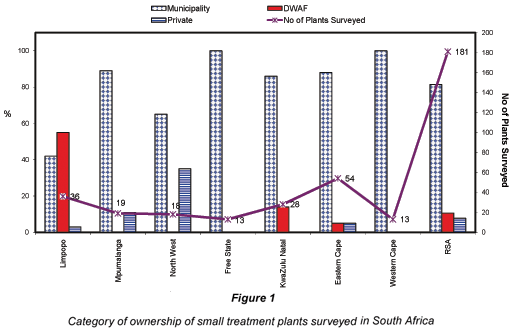
In Mpumalanga Province the local municipalities are the major owners with the exception of the Nelspruit Water Treatment Plant that is now owned by Biwater (Pty) Limited (South Africa), which is a private company. In Limpopo, plant ownership has been divided between the local municipalities and DWAF. In the North West Province, the ownership of the plants has been divided into 2 categories, viz. local municipalities and water boards (Botshelo Water and Magalies Water). Sixty seven percent of the plants are owned by local municipalities while Botshelo and Magalies Water own 22% and 11% of the plants respectively. Five (Taung, Wolmaranstad, Kudumane, Stella, Vryburg) of the towns in the Province are supplied by Sedibeng's Water Treatment Plant, which is situated in the Free State Province. Eighty six percent of small water treatment plants are owned by district municipalities in the KwaZulu-Natal Province. In the Eastern Cape Province, 88% of plants are owned by the district municipalities with the remainder distributed amongst the Department of Water Affairs and Forestry, the Department of Health and a private company (Water and Sanitation Services of South Africa – WSSA) which manage the plants on behalf of the district municipality. All the plants surveyed in the Free State Province and in the Western Cape Province are owned by the district municipalities. Overall 81% of the small water treatments surveyed in South Africa are owned by the district municipalities (Fig. 1).
Design capacity of small water treatment plants
The capacity of the plants surveyed during the investigation varied between 0.3 Mℓ/d and 120 Mℓ/d. Most plants were operating below the design capacity.
In Mpumalanga, small water treatment plants situated in peri-urban regions usually provide water to the towns, townships as well as to some villages. Package plants were observed to be rare and few cases were recorded. The largest plant visited in Mpumalanga was Witbank with a design capacity of about 120 Mℓ/d. Most of the plants had a capacity of more than 1 Mℓ/d. Some plants were in the process of being upgraded or had recently been upgraded. However, in Limpopo, most of the plants were package plants with a capacity of less than 1 Mℓ/d. The largest plant was found in Mhinga with a design capacity of 37 Mℓ/d.
In the North West Province, the design capacities of the plants ranged between 1.3 and 60 Mℓ/d. The Mafikeng water treatment plant was the largest plant and had a design capacity of 60 Mℓ/d. The majority of the plants were operating below the design capacity. The capacity of the plants investigated in the Free State Province ranged between 0.5 Mℓ/d and 11.5 Mℓ/d. The largest plant was at Parys with a capacity of 11.5 Mℓ/d. The plant with the lowest capacity (Oranjeville) was in the process of being upgraded. In KwaZulu-Natal, the design capacities of the plants visited ranged from small waterworks with capacities of 100 m3/d (Manjokeni Waterworks, situated near Bergville) to largest capacity plant of 32 Mℓ/d (Ezakheni Waterworks in Eastcourt). Due to the lack of plant records and flow meters in most plants especially in rural and peri-urban areas, the design capacities were assessed based on the dimensions of the unit operations.
In the Eastern Cape, the Umtata Waterworks plant was the largest plant visited during the survey period, with a design capacity of 60 Mℓ/d; however, most of other plants were designed for more than 1 Mℓ/d. Most of these plants were operating below design capacity. Nearly half of the plants were undergoing some sort of upgrading or had recently completed the upgrading. In the Western Cape, the design capacities of the plants visited ranged between 1 and 60 Mℓ/d. The largest plant visited was George Water Treatment Plant with a design capacity of 60 Mℓ/d. While 62% of the plants were designed for less than 10 Mℓ/d, 38 % of the plants had a design capacity ranging between 11 and 30 Mℓ/d. The majority of the plants were operating below their design capacity. The Sandhoogte Waterworks was the only plant that was undergoing an upgrade.
Type of raw water sources
Figure 2 illustrates the types of raw water sources used by small water treatment plants in the designated provinces. Overall 86% of the small water treatment plants surveyed in South Africa abstracted their raw water from surface water, although 10% of the plants used groundwater or a combination of both water sources (4%). In Mpumalanga, only 5% of the waterworks surveyed abstracted intake water from groundwater. In Limpopo, 6% of the plants abstracted intake water from groundwater and 3% used a combination of both surface and groundwater sources. The North West Province had the highest usage of groundwater (24%). A few of the plants draw water from unprotected springs. The surface water in the province was generally characterised by high turbidity and some of the dams were highly polluted with algae. In the Western Cape, the majority of the plants were designed for the removal of colour, iron and manganese.
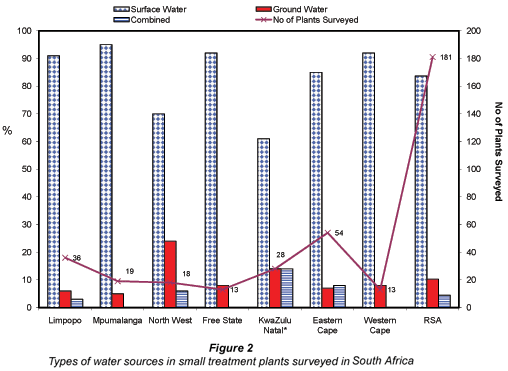
Water treatment practices
Conventional water treatment processes were generally used in the majority of the plants surveyed. In some of the plants that abstracted groundwater, the only form of treatment practised was disinfection. Interestingly, one of the small water treatments surveyed was a desalination plant which was close to Port Alfred in the Eastern Cape and fell under the control of Albany Water. The plant used membrane filtration followed by disinfection with chlorine. The unit processes and methods of disinfection used in the various treatment plants are summarised in Figs. 3-5.
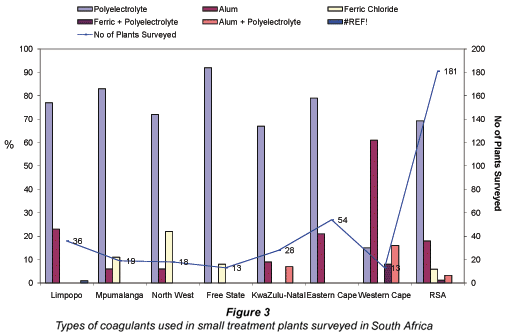
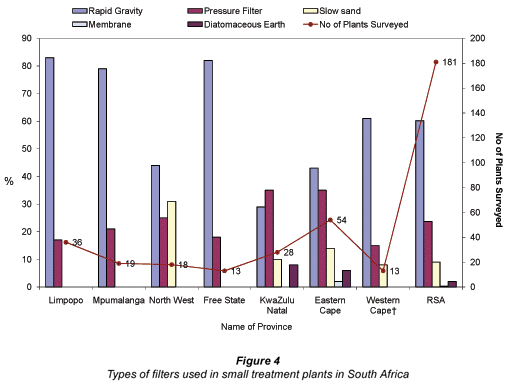
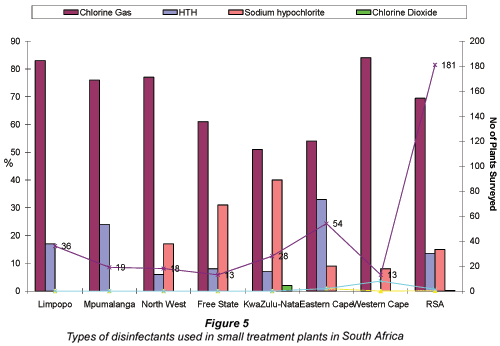
In terms of coagulation, the survey has confirmed a general trend in South Africa where there has been a strong move towards the use of polyelectrolyte as a substitute for alum and ferric chloride with 69% of the plants surveyed now using these chemicals. The Free State had the highest usage of polyelectrolyte and 92% of the plants are currently using these coagulants. The Western Cape was the highest user of alum (61%) and the North West Province showed the highest use of ferric chloride (22%) (Fig. 3).
Sixty percent of the small treatment plants surveyed used rapid gravity filtration systems with a further 24% using pressure filters. Only 9% of the plants were using slow sand filtration systems. It was interesting to find that 14 plants were using diatomaceous earth filters which are predominantly used in large municipal swimming pool systems. The North West Province had the highest (31%) application of slow sand filtration while the Western Cape had the lowest (8%). No sand filtration systems were used in Limpopo, Mpumalanga and Free State Provinces which had the highest application of rapid gravity filtration (Fig. 4).
Chlorine gas was found to be the most popular disinfectant with 69% of the small treatment plants using this chemical, followed by sodium hypochlorite (15%) and calcium hypochlorite (HTH) (14%). The highest application of sodium hypochlorite was noted in KwaZulu-Natal (40%) followed by the Free State (31%). The highest application of HTH was noted in the Eastern Cape (33%). No application of sodium hypochlorite was found in Limpopo, Mpumalanga and Western Cape. Only one instance of the application of chlorine dioxide, sodium bromide and ozone was found in the country at the following plants: Wild Coast Casino, Libode and Jeffreys Bay, respectively (Fig. 5).
Quality of drinking water produced by small water treatment plants
Physicochemical compliance
The results of the analyses for all water samples collected at various plants fell within SANS Class I in terms of pH (5 to 9.5) and conductivity (<150 mS/m) (SANS 241, 2005).
For efficient disinfection, DWAF, DoH and the WRC (1998) recommend that the turbidity of drinking water should be less than 1 NTU and preferably less than 0.5 NTU. The maximum turbidity limit allowable by SANS 241 ranges between 1 and 5 NTU (2005). Water samples collected at the point of treatments showed that 44% and 38% of the small water treatments surveyed in South Africa fell within SANS Class I (< 1 NTU) and Class II (1-5 NTU), respectively. The remaining plants had turbidity values of higher than 5 NTU (Fig. 6). At the point of consumption, 46% and 41% of the plants fell within Class I and Class II, respectively (Fig. 7). The highest turbidity compliance was noted in Free State at both point of treatment (Class I: 73% of the plants and Class II: 27%) and consumer's taps (Class I: 69% of the plants, Class II: 31% of the plants). In this province, no small water treatment plant exceeded the maximum turbidity limits allowed by SANS 241.
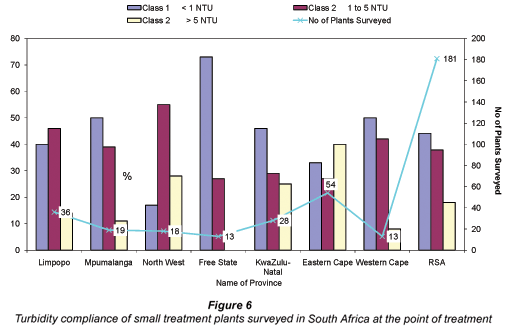
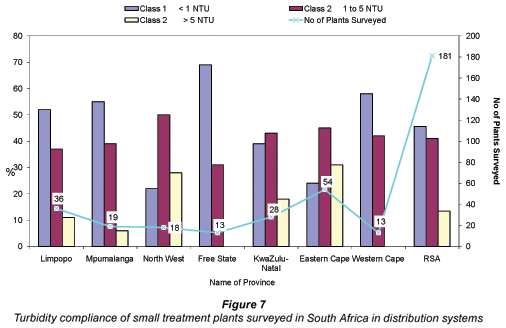
The high turbidity compliance in the Free State Province might be attributed to the partnership that has been established between this Province and a technical support organisation (CSIR). Each plant receives a visit from the technical support organisation representative at least once per month to advise the operators on process control issues. The lowest turbidity compliance was noted in the Eastern Cape Province with 40% and 31% of the plants showing the highest turbidity values at the point of treatment and at the point of use, respectively. The turbidity values recorded from most water samples collected in these plants exceeded the allowable maximum limits set by SANS 241:2005.
The North West had 28% of the plants not complying with the maximum turbidity limits at the point of treatment as well as at the point of use. Mpumalanga and Western Cape had 39% and 42% of the plants falling within Class II at both points of treatment and points of use, respectively (Figs. 6-7).
High turbidity values interfered with the concentrations of free chlorine residual at the point of treatment as well as at the point of use. This made it more difficult to maintain an adequate residual which could protect the drinking water against pathogenic micro-organisms. Free chlorine residual is the primary indicator of microbial safety used in process controls. Adequate disinfection then requires a free chlorine concentration of at least 0.5 mg/ℓ in the final water leaving the plant after a contact time of at least 30 min at a pH less than 8 (DWAF et al., 1998; WHO, 2004) . The free chlorine residual concentration at the point of delivery should be at least 0.2 mg/ℓ under normal circumstances and 0.5 mg/ℓ during periods of high risk of microbial contamination (WHO, 2004). To combat any possible contamination in the network and to protect public health, the South African Assessment Guide for the Quality of Domestic Water Supply recommends the ideal target range of 0.3 to 0.6 mg/ℓ free chlorine residual at the consumer's tap water (DWAF et al., 1998). This was not the case in 44% of the plants visited during the survey (Fig. 8).
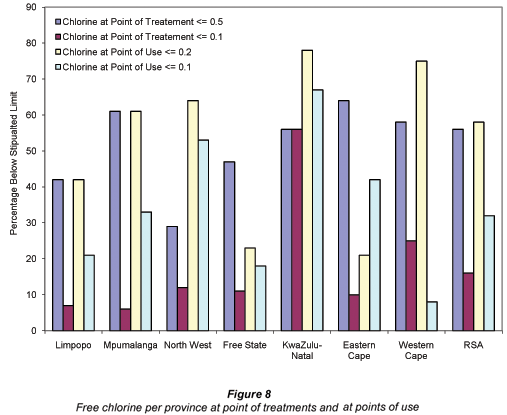
Water samples collected at the point of treatment indicated that 16% of the plants had a minimum free chlorine concentration < 0.1 mg/ℓ and 56% had a free chlorine concentration < 0.5 mg/ℓ. At the point of use 32% of the plants had free chlorine concentrations of below 0.1 mg/ℓ and 48% had below 2 mg/ℓ in each province (results not shown). It was noted that many operators were not aware of the chlorine dose added in the raw water after filtration and in most of the plants the flow rate of the intake water was not known. Many of the plants either overdosed the chlorine or under chlorinated the drinking water and this led to chlorine values outside the recommended limits.
Microbiological compliance
Figures 9-10 illustrate the microbiological quality of water supplied by plants surveyed. Overall, 67% and 72% of the plants complied with the South African drinking water recommended limits for total coliforms and faecal coliforms at the point of treatment, respectively.

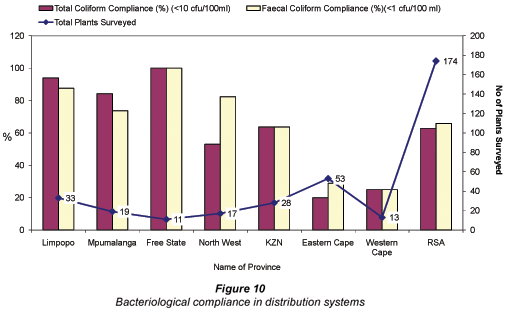
In Mpumalanga, 95% of the plants at the point of treatment and 84% at point of use complied with the South African water quality standard in terms of total coliforms. Seventy four percent of the plants were within the limits recommended by South African standards in terms of faecal coliforms at both the point of treatments and the point of use. Total coliform counts ranged between 0 and 380 cfu/100 mℓ at the point of treatment and between 0 and 180 cfu/100 mℓ at the point of use, while faecal coliform counts ranged between 0 and 3 cfu/100 mℓ at the point of treatment and between 0 and 12 cfu/100 mℓ at the point of use.
In Limpopo, 64% of the plants at the point of treatment and 94% at point of use of the plants complied with the South African recommended standard in terms of total coliforms. The total coliform counts ranged between 0 and 3.6 x 103 cfu/100 mℓ at the point of treatment and between 0 and 250 cfu/100 mℓ at the point of use. In terms of faecal coliforms, 73% and 88% of the plants complied with South African drinking water recommended limits at the point of treatment and at the point of use, respectively. Faecal coliform counts ranged between 0 and 60 cfu/100 mℓ and between 0 and 7 cfu/100 mℓ at the point of treatment and at the point of use, respectively.
In the North West Province, 76% of the samples from the plants at point of treatment and 53% at the point of use complied with the South African recommended limits in terms of total coliforms. Total coliforms ranged between 0 and 83 cfu/100 mℓ at the point of treatment and between 0 and 288 cfu/100 mℓ at the point of use. A total of 94% and 83% of the plants were found within the recommended limits for faecal coliforms at the point of treatment and at the point of use respectively. Faecal coliform counts ranged between 0 to 5 cfu/100 mℓ and between 0 to 13 cfu/100 mℓ at the point of treatment and at the point of use, respectively.
The microbiological data of the plants visited in the Free State Province revealed 100 % compliance with the SANS standard in terms of total coliforms and faecal coliforms at the point of treatment. At the point of use 92% compliance was obtained for total coliforms and 85% compliance for faecal coliforms. The above non-compliance represented 2 points in the distribution system and it must be noted that overall the plants in the Free State were producing excellent water quality.
In KwaZulu-Natal, 57% of the plants at point of treatment complied with the SANS standard for total coliforms and 61% complied for faecal coliforms. At the point of use, 64% plant compliance was obtained in terms of total and faecal coliforms. Total coliform counts ranging up to 866 cfu/100 mℓ were detected at one site at the point of treatment with corresponding faecal coliform counts of 53 cfu/100 mℓ. At the point of use an alarmingly high total coliform count of 2 419 cfu/100 mℓ was detected at one of the sites with a corresponding faecal coliform count of 36 cfu/100 mℓ. The primary cause of this failure was due to either lack of chlorination facilities or under-dosing of chlorine.
In the Eastern Cape Province, at the point of treatment 28% of the plants complied with the SANS standard in terms of total coliforms and 34% complied in terms of faecal coliforms. At the point of use 20% of the plants complied in terms total coliforms and 29% complied in terms of faecal coliforms. Total coliform counts ranging up to 240 cfu/100 mℓ were noted at the point of treatment of one of the plants and 223 cfu/100 mℓ at one of the points in the distribution system. A maximum faecal coliform count of 25 cfu/100 mℓ was detected at one of the points of treatment while 98 cfu/100 mℓ was noted at one of the points in the distribution system. In the Western Cape, 50% of the plants complied in terms of total coliforms and 25% for faecal coliforms at the point of treatment. In the distribution system, there was 25% compliance for both total and faecal coliforms.
Compared to other provinces, the Eastern Cape Province produced the lowest potable drinking water quality in terms of both total and faecal coliforms while the Free State produced the best drinking water quality. These results confirm the poor microbiological quality of the drinking water in the Eastern Cape that was also noted by Momba and co-workers (2004) in a previous study conducted in the Alice Water Treatment plant.
It is important to note that the quality of water reaching consumers depends not only on operating conditions at the treatment plant but also on changes that can occur in the distribution system. During the survey period, it was noted that final drinking water of the highest quality might be leaving some plants but its condition would deteriorate to some extent before it reached the consumers. High turbidity in the finished water, old pipes, breaks in distribution pipelines, biofilm growth, sludge accumulation in the storage reservoirs and the availability of nutrients for microbiological growth could be among the factors that accelerate the chlorine residual decay of final drinking water at the point of use (Momba et al., 2000).
To ensure the absence of bacterial pathogens, the drinking water should be free of faecal organisms. The primary bacterial indicator recommended for this purpose is the coliform group of organisms (DWAF, 1996; WHO 2004; SANS 241: 2005). The presence of faecal coliforms in treated water indicates poor or inadequate treatment of drinking water. Higher concentrations of faecal coliforms in treated water indicate a high risk of contracting waterborne disease, even if small amounts of the water are consumed (DWAF, 1996). This statement could be applied to 28% of the plants surveyed that failed to produce safe drinking water in terms of faecal coliforms.
Control and monitoring
In Limpopo and Mpumalanga, most of the operators and supervisors interviewed did not have a good knowledge of the flow rate at which their plants were being operated. Generally the chemical dosing rates were determined by experience. Very few knew what their chemical dosage rates were or how to calculate them. Coagulant doses were adjusted manually, usually based on the appearance of the floc and sometimes also based on the taste of the water when alum was used. Chlorine doses were set manually and some plants were overdosing chlorine. Nearly all of the plants reported that an external monitoring group visited the plants approximately once a month although most plants complained about a lack of feedback from the external monitors. Most of the plants were partially automated which facilitated the operator's work and limited some overdosing errors and ensured that remote reservoirs were kept full. In Mpumalanga, most plants had instruments to measure turbidity, pH and chlorine residual although these were not always used. The maintenance of equipment in some plants was not taken into account.
In the North West Province, 60% of the plants were equipped with raw water flow meters; however, readings were only recorded in plants owned by water boards and in three of the municipality-owned plants. It was noted that 66% of the plants had jar stirrers on-site; however, these were only used in four of the plants. Less than 20% of the supervisors and operators knew the required chemical dosing rates or how to calculate them. Chemical dosages were adjusted based on the appearance of the floc and the colour of the finished water. All the plants measured chlorine residuals; however, less than half of them measured turbidity and pH. Only one plant was testing the general chemical and microbiological quality of water. Four municipal plants were monitored by local health inspectors; however, the plant staff did not get any feedback on the water quality results. The waterworks owned by Botshelo Water were equipped with a telemetry system and Supervisory Control and Data Analysis (SCADA) system for the monitoring of the entire plant.
In the Free State, some of the operators and supervisors interviewed knew the flow rates at which their plants operated but very few knew what their chemical dosage rates were or how to calculate them. Seventy percent of the plants had the instruments to measure turbidity, pH and chlorine residual. Fourteen percent of the plants measured chlorine only, and 14% did not have any on-site monitoring programme. All of those plant operators interviewed were aware of the importance of measuring these parameters but were typically unable to persuade the municipality to buy the instruments (however, basic instruments usually came with major upgrades). A number of supervisors used swimming pool test kits to measure pH and chlorine. Coagulant doses were adjusted manually, usually based on the appearance of the floc. However, in one case, the dosage of the flocculants was automatically controlled by an ion charge analyzer. Chlorine dosages were also set manually.
In KwaZulu-Natal, 15% of the plants had functioning raw water meters, 10% had installed meters but were non-functional, and operators indicated that the meters had been non-functional for many years. Lack of maintenance of equipment was reported in 80% of the plants. Seventy percent of the plants were not able to calculate the chemical doses and the operators were running the plants by visual observation of the clarifier overflow. Only 20% of the plants had on-line instruments for measuring turbidity and pH and 70% had bench- scale equipment for measuring pH, turbidity and chlorine. On-site jar test equipment was recorded in 5% of the plants; however, only 2% were capable of conducting a jar test. None of the plants were undertaking chlorine demand tests on site. External process audits were undertaken at 30% of the plants and involved in detailed assessment of the plant optimisation. These plants were managed mainly by water boards such as Umgeni Water and Umhlatuze Water. Seventy percent of the plants were measuring process parameters and capturing onto daily log-sheets; however, limited quality control of these data was practiced. At plants managed by water boards, process technicians visited the plants at least once a month to assist with optimisation of the plant. The process technicians were responsible for a number of plants and rotated their service between the plants. In the larger water boards, process engineers and process scientists were available at short notice for trouble shooting process problems as well as to follow up on water quality failures. Supervisors and works managers were only available at 20% of the plants that were visited.
In the Eastern Cape Province, 50% of the operators and supervisors interviewed knew the flow rates at which their plants operated; 78% did not know the chemical dosages used or how to correlate the required dose to the flow rate; 46% had the instruments to measure turbidity, pH and chlorine residual; 3% of the supervisors used swimming pool test kits to measure pH and chlorine; 95% of the plants reported that an external monitoring group visited the plants approximately once a month; and 20% of the plants were partially automated. However, most plant operators complained about a lack of feedback.
In the Western Cape, it was found that all the plants were equipped with raw water-flow meters. Most of the operators reported that raw water flow was adjusted if there was high demand of water or during rainy seasons. The majority of the plants owned jar stirrers. Almost all the plants measured chlorine residuals and pH; however, less than half of the plants measured the turbidity of the water. Nearly all of the plants reported that an external monitoring group visited the plants approximately once a month and they were receiving feedback. More than a half of the plants visited during the study period were equipped with a SCADA and telemetry system to monitor the whole plant.
Recent developments within DWAF show increased emphasis on monitoring of drinking water quality. The Delmas incident in South Africa in 2005 resulted in 600 cases of typhoid, 5 documented deaths, and 3 300 cases of diarrhoea. Escherichia coli were found in one of the town's reservoirs and the lack of treatments, especially chlorination, was found to be a major contributing factor to the tragedy (Van Vuuren, 2005). This incident could have been prevented if a proper control and monitoring programme had been established in the region.
Poor maintenance practices
Lack of maintenance of equipment was noted to be a major management problem. About 60% of the SWTP operators interviewed in all the provinces studied (Eastern Cape, Free State, Western Cape, Mpumalanga and Limpopo Provinces) mentioned that equipment was not regularly maintained. This led to periodic equipment failures and the consequences of poor water quality. Indeed some operators asserted that the culture in most SWTPs was a culture of repairs or replacement of equipment and not maintenance of equipment. Several factors have been implicated to fan the poor maintenance culture. Such factors included lack of technical skills and appropriate training, inadequate or lack of relevant experience, inadequate funds and personnel. For example in North-West, Western Cape, Free State, KwaZulu-Natal, Eastern Cape, Mpumalanga and Limpopo Provinces, between 5.88% and 46.30% of the operators reportedly had educational qualifications of standard 8, 42% to 62% with Matric (with the exception of KwaZulu-Natal – 80%) whereas 0 to 53% were enrolled in post-Matric (Grade 12) qualifications. The implications of these trends are enormous because they typify the shortcomings and potential dangers in the water delivery system due to lack of appropriate qualifications and training. The in-service training component is exemplified by the fact that in all the SWTPs studied, in the respective provinces, about 7 to 63% of the operators had not undergone relevant and appropriate training to enable them to acquire technical skills for the job (Table 1).
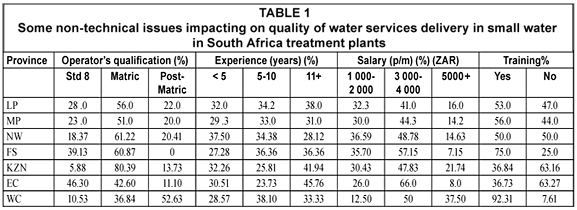
The main role of operators is to control the equipment and processes that remove or destroy harmful chemical compounds and micro-organisms from the water. This role is therefore mired in controversy because most of the operators lack technical knowledge of the equipment and technical processes. Some operators were not aware of how to determine flow rates, chlorine dosage or even the concept of chlorination as well as maintenance of technical equipments, measurement and documentation of processes. Above all, they lacked computational skills in an era of a rapidly changing information technology system. The ripple effects of these shortcomings cannot therefore be ignored and should indeed be placed in the context of the reported management problems in some local government authorities (LGAs) in South Africa
Training and capacity building
Lack of technical skills has been highlighted as one of the major challenges to sustained quality water provision. Potential areas for capacity development include technical, managerial, marketing and public relations. This challenge underscores the need for upgrading and training of personnel but this has not been actively pursued by SWTPs in all the provinces studied (Table 1). The need for training is underscored by the inability of plant operators to calculate chlorine doses and calibrate or maintain equipment (Momba et al., 2004a; b; Momba et al., 2005a; b; c). This issue is compounded by a shortage of human resource capacity in over 70% of SWTPs visited in the designated provinces.
Coordinated efforts should equally be put in place to maximise the human resource capacity available in water- provision support systems in the provinces. Such efforts could be achieved through strategic partnerships with relevant support agencies. Such partners could include academic institutions, research bodies, community social networks, CBOs, NGOs and relevant government departments. Partnership with research and academic institutions also offers opportunities for technical assistance and manpower through internship programmes where suitably prepared students and research fellows can take part in water supply activities (Momba and Brouckaert, 2005a; Momba et al., 2005c). Capacity building should therefore cover a range of issues such as technical, social, finance, managerial and institutional.
Specific technical needs of the treatment plants could include development of computational skills for plant operators, dosing calculations, calibration, operation and maintenance of technical equipment, measurement and documentation of processes and the interpretation of records or reports, measuring flow rate and use of instruments.
Poor recording, documentation and communication
Beyond the mechanical components in safe water supply, maintaining the quality of water supply is equally affected by the availability of adequate stocks of water treatment chemicals. For instance, an interruption in the supply of coagulants or disinfectants (as was the case in some SWTPs studied either due to system failures or unavailability) would constitute a major emergency. To avoid this danger, proper recording of the rate of use of the various chemicals and actual stock taking by water treatment plant operators and timely replenishment is essential. This should also be closely monitored by higher authorities. However, respondents of the various SWTPs studied noted poor recording and documentation by different levels of management as the principal causes for stock depletion or interruption of supply of chemicals, reagents and equipments. In most cases, operators lacked knowledge of the exact inventory of chemicals, reagents and equipments. This lack of knowledge will obviously lead to various stock depletions, with ripple effects on quality of service delivery.
In the event of the distribution of unsafe water, appropriate emergency plans should be instituted to avert or minimise the effect of the poor water quality. Such plans would initially consist of emergency prevention measures which are mostly related to plant maintenance, strikes and sabotage, natural disasters, equipment failures, ensuring adequate supply of chemicals, and various measures to protect the water treatment and distribution systems. Unfortunately over 50% of the operators were not aware of the existence of emergency prevention methods. This was generally attributed to poor communication between operators and management or operators and consumers. Effective communication ensures buy-in of relevant stakeholders, community sensitisation and awareness and building of strategies to address pertinent issues and alert households to the need to boil water or to treat water, by any other method, when water is suspected to be of poor quality.
Conclusions and recommendations
It is concluded that although ownership of the plants belonged to 4 categories such as the district/local municipalities, DWAF, DOH and private companies (water boards), over 80% of the plants were noted to be owned by the district municipalities. In addition, about 84% of the small water treatment plants in the designated provinces abstracted their raw water from surface water. Conventional water treatment processes were generally employed; more than 80% of the small water treatments employed the rapid gravity and pressure filtration systems. Chlorine gas was observed to be the most common disinfectant used (69%), followed by sodium hypochlorite (15%) and calcium hypochlorite (14%). Furthermore, a substantial number of the small water treatment plants engaged operators with limited technical understanding of the treatment processes, leading to either an overdose or an under-dose of coagulants and chlorine. Generally in terms of microbiological parameters employed, Free State and Eastern Cape Provinces produced the safest and poorest water quality respectively. Finally, some of the small water treatment plants were devoid of basic monitoring equipment such as flow meter, pH meter, jar test apparatus, turbidity meter, chlorine meter and colorimeter. These have led to lack of flow rate, turbidity, pH and chlorine residual measurements.
It is strongly recommended that the following operational practices be implemented:
• All small water treatment plants must be provided with basic functioning raw and final water flow meters.
• Accurate records of flow into and out of the plant must be recorded on a daily basis or whenever a change in flow rate is made.
• All the treatment plants must acquire jar stirrer apparatus to determine the optimum dosage of the coagulants. Jar tests must be conducted at least once per week or when the raw water quality changes.
• Plant operators must monitor pH at various points in the plant for coagulation control. The turbidity of the final water must be monitored and the chlorine dose has to be applied proportionally to the plant flow rate. To ensure effective disinfection, measurement of the chlorine demand of water is highly recommended.
• For a monitoring programme to be effective, each small water treatment plant must be equipped with a jar stirrer, turbidity meter, pH meter and a chlorine meter. A programme for monitoring the physicochemical (at least pH, temperature, turbidity and free chlorine residual) and bacterial (coliform bacteria, especially faecal coliform) quality of water at the point of treatment and various sites of the distribution systems must be established.
Acknowledgments
Financial support for this study was provided by the Water Research Commission of South Africa. The authors also acknowledge the contribution of the various small water treatment plants towards the successful execution of the study.
References
DEPARTMENT OF WATER AFFAIRS AND FORESTRY (DWAF) (1996) South African Water Quality Guidelines for Domestic Use (2nd edn.). DWAF, Pretoria, South Africa. [ Links ]
DEPARTMENT OF WATER AFFAIRS AND FORESTRY (DWAF) DEPARTMENT OF HEALTH (DoH) and WATER RESEARCH COMMISSION (1998) Quality of Domestic Water Supplies. Assessment Guide 1 (2nd edn.). WRC Report No. TT 101/98. Water Research Commission, Pretoria, South Africa. [ Links ]
MACKINTOSH GS and COLVIN C (2003) Failure of rural schemes in South Africa to provide potable water. Environ. Geol. 44 (1) 101-105. [ Links ]
MOMBA MNB, TYAFA Z and MAKALA N (2004 a) Rural water treatment plants fail to provide potable water to their consumers: the Alice water treatment plant in the Eastern Cape Province of South Africa. S. Afr. J. Sci. 100 307-310. [ Links ]
MOMBA MNB, MAKALA N, TYAFA Z, BROUKAERT BM, BUCKLEY CA and THOMPSON PA (2004 b) Improving the efficiency and sustainability of disinfection at a small rural water treatment plant. Water SA 30 (5) 617-622. [ Links ]
MOMBA MNB and BROUCKAERT MB (2005a) Guidelines for Ensuring Sustainable Effective Disinfection in Small Water Supply Systems. WRC Report No. TT 249/05. Water Research Commission, Pretoria, South Africa. [ Links ]
MOMBA MNB, TYAFA Z, MAKALA N and BROUCKAERT BM (2005b) A model partnership for sustainable production of safe drinking water for rural communities in South Africa. S. Afr. J. Sc. 101 (5/6) 335-336 [ Links ]
MOMBA MNB, MAKALA N, ZANI B and BROUCKAERT BM (2005c) Key causes of drinking water quality failure in a rural small water supply of South Africa. In: Lehr JH and Keeley J (eds.) Water Encyclopaedia – Domestic, Municipal, and Industrial Water Supply and Waste Disposal. John Wiley & Sons, Inc. 221-227. [ Links ]
MOMBA MNB, TYAFA Z, MAKALA N, BROUCKAERT BM and OBI CL (2006) Safe drinking water still a dream in rural areas of South Africa. Case Study: The Eastern Cape Province. Water SA 32 (5) 715-720. [ Links ]
OBI CL, MOMBA MNB, SAMIE A, IGUMBOR JO, GREEN E and MUSIE E (2007) Microbiological, physicochemical and management parameters impinging on the efficiency of small water treatment plants in the Limpopo and Mpumalanga Provinces of South Africa. Water SA 33 (2) 1-9. [ Links ]
SANS 241 (2005) South African National Standard – Drinking Water (6th edn.). Standards South Africa ISBN 0-626-17752-9. [ Links ]
STANDARD METHODS (1998) Standard Methods for the Examination of Water and Wastewater (20th edn.). American Public Health Association (APHA). 2005-2605. [ Links ]
SWARTZ CD (2000) Guidelines for the Upgrading of Existing Small Water Treatment Plants. WRC Report No. 738/1/00. Water Research Commission, Pretoria, South Africa. [ Links ]
VAN VUUREN L (2005) A word from the editor – Who's our typhoid Mary? The Water Wheel November/December. 4. [ Links ]
WHO (1982) Rural Water Supplies. World Health Organisation (WHO) Stevenage, UK, [ Links ]
WHO (2004) Guidelines for Drinking Water Quality (3rd edn.) Vol. 1: Recommendations. World Health Organization. Geneva, Switzerland. [ Links ]
Received 12 March 2008; accepted in revised form 21 May 2009.
* To whom all correspondence should be addressed.
+2712 382 6365; fax: +2712 382 6233;
e-mail: mombamnb@tut.ac.za














